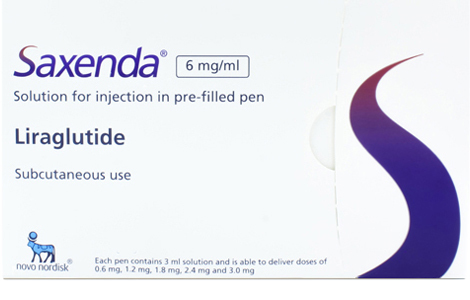Saxenda is out of stock. Nevolat, which has the same active ingredient, is available. Switch with no break in treatment
Saxenda
What is Saxenda?
Part of our weight loss treatment plan
Saxenda is a once-daily injection that you administer to yourself to aid weight loss. It contains the active ingredient Liraglutide, which is very similar to a naturally occurring hormone in your body called GLP-1. The weight loss injection works by making you feel less hungry, slowing down the emptying of your stomach and making you feel 'fuller' for longer.

Saxenda is approved to help you lose weight in conjunction with an active lifestyle and a calorie-controlled balanced diet.

Saxenda weight loss injections should be taken alongside a calorie-controlled diet and exercise to help you lose weight. Exercise and a balanced diet will help you maintain a healthy weight even when you stop taking your medication.
How does Saxenda work?
Saxenda (liraglutide 6mg/ml) is a self-injectable weight loss treatment. It contains the active ingredient liraglutide which is very similar to a naturally occurring hormone in your body called GLP-1.
After a meal GLP-1 is naturally released from your intestines.
It works in a part of the brain, where it interacts with specific neurons involved in the regulation of appetite and food intake.
Saxenda® increases feelings of satiety (fullness) and decreases hunger.
As a result of its mechanism of action, patients taking Saxenda® feel satisfied and eat less food, leading to weight loss.
Saxenda Weight Loss
Saxenda makes you feel full for longer and therefore less hungry, which helps patients to eat less and in turn reduce their body weight. The reduced appetite helps you to lose weight and keep it off in the long term. When you join PrivateDoc we will assess your individual circumstances to see if we think Saxenda will help with your weight management.
How much does Saxenda cost?

Saxenda is out of stock. Nevolat, which has the same active ingredient, is available. Switch with no break in treatment
Is Saxenda suitable for me?
Saxenda can only be used as a weight-loss treatment if you have previously tried and failed to lose weight through diet and exercise alone.
You can expect to lose a minimum of 5% of your initial body weight after completing 12 weeks of treatment at 3.0mg liraglutide daily. If you have not lost 5% of your initial body weight after 12 weeks at 3.0mg, then treatment should be discontinued at this stage.
Get StartedIs there any evidence that Saxenda works?
Saxenda has been studied extensively in multiple clinical trials to establish its clinical benefits (4 x phase 3 trials – SCALE Obesity & Pre-Diabetes, SCALE Diabetes, SCALE Sleep Apnoea and SCALE Maintenance).4
These trials included a total of 5,358 participants and the trials ran between 56 weeks and 160 weeks. Superior weight loss was achieved with Saxenda (liraglutide) compared to diet and exercise alone in obese and overweight patients in all groups studied. More than twice as many people achieved 5% and 10% body weight loss compared to diet and exercise alone.
How do I use Saxenda?
Saxenda comes in a 3ml pre-filled weight loss injection pen. The pen contains a clear and colourless or almost colourless solution. All weight loss pens are supplied with the right quantity of needles you require for injecting. You will need to store your Saxenda pre-filled pen in a refrigerator (2°C to 8°C) before your first use. Once you start using the pen, you can keep it for 1 month either at room temperature (2 to 30°C) or in a refrigerator (2°C to 8°C). Do not freeze.
When you take Saxenda you need to gradually increase your dose in 0.6mg intervals, until you reach what is called the maintenance dose at 3mg daily. This is the dose at which you will continue to take Saxenda. You increase your dose as follows:
- Week 1 – 0.6mg as a once-daily injection
- Week 2 – 1.2mg as a once-daily injection
- Week 3 – 1.8mg as a once-daily injection
- Week 4 – 2.4mg as a once-daily injection
- Week 5 onwards – maintenance dose of 3.0mg as a once-daily injection
Increasing the dose slowly over time should minimise any unwanted side effects, such as nausea, vomiting and diarrhoea. As you increase your dose, if you find that you cannot tolerate your side effects, you should stay on the same dose for 2 continuous weeks. If after 2 weeks your side effects are still not tolerable, you should consider stopping treatment.
The maximum recommended daily dosage of liraglutide is 3.0mg. Try to take it at the same time each day, picking a time that works for you, with or without food or drink.
You must continue with your new diet and exercise regime while you are taking Saxenda.
Always use Saxenda exactly how your prescriber has told you. Check with your doctor, pharmacist or nurse if you are unsure.
When you first start Saxenda, a single pen will last 17 days and the first full pack of five pens will last six weeks. Once you have achieved the maintenance dose, a pack of five pens will last 30 days.
How much does Saxenda cost?How do I administer my Saxenda injection?
Saxenda is a self-administered subcutaneous injection that you inject under your skin. The best sites for injecting are the front of your waist (abdomen), the front of your thigh or the upper arm. You must take extra care not to inject into a vein or muscle.
If you accidentally use more Saxenda than you should, you must talk to a doctor or go to a hospital straight away. You may experience nausea or vomiting and may require medical treatment.
If you forget a dose, you can inject it as soon as you remember, as long as it is within 12 hours from when you usually take your dose. However, if more than 12 hours have passed since you should have used Saxenda, miss the dose and inject your next dose the following day at the usual time. Never use a double dose or increase the dose on the following day to make up for the missed dose. If there has been more than 72 hours (three days) between doses, you should return to the 0.6mg starting dose and work through the doses as you did when you first started treatment.
What information does PrivateDoc need to know about me?
You cannot use Saxenda if you:
- are pregnant, breastfeeding or planning to become pregnant
- have any known allergies to any of the ingredients in Saxenda
- are under 18 years old or over 75 years old
- have diabetes and are taking other medicines that contain GLP-1 (such as exenatide or lixisenatide) or have issues with hypoglycaemia (low blood sugar)
- have severe heart failure
- have liver or severe kidney disease or are on dialysis
- have severe stomach or gut problems such as gastroparesis (delayed stomach emptying) or inflammatory bowel disease
If you have any of the following conditions you will need to speak with the doctor as Saxenda may not be appropriate for you:
- Diabetes
- Diseases of the pancreas
- Inflamed gall bladder or gallstones
- Thyroid diseases including thyroid nodules and enlargement of the thyroid gland
- Heart palpitations or a racing heart
- Mild to moderate liver or kidney disease
- A condition that requires you to take anticoagulants such as warfarin
Where do I inject Saxenda?
Saxenda is a self-administered subcutaneous injection that you inject under your skin. The best sites for injecting are the front of your waist (abdomen), the front of your thigh or the upper arm. You must take extra care not to inject into a vein or muscle.
How much does Saxenda cost?
Saxenda comes in a 3ml pre-filled injection pen and costs from £47.50 per weight loss pen. You have the choice of buying between one and five pens. When you first start Saxenda, a single pen will last 17 days.
Saxenda pack sizes and prices?Saxenda Unboxing
Interested in finding out how your Saxenda weight loss treatment travels and arrives to you? Check out this video to view our Saxenda treatment unboxing to know what to expect once your treatment is approved and shipped.
Watch our Saxenda unboxing videoWhat are the possible side effects of taking Saxenda?
As with all medication, Saxenda can be associated with unwanted side effects. Although usually mild, some can be more severe, which may result in your treatment being stopped. You should always read the patient information leaflet fully before you begin treatment.
When you first start your treatment, you may experience some stomach upset, such as vomiting or diarrhoea, and may also lose some bodily fluids. Therefore, it is important to drink plenty of fluids to keep yourself hydrated. Most mild side effects will settle once your body gets used to the new medication. However, if any side effect persists, stop the treatment and talk to a doctor.
Sometimes side effects of Saxenda can be very serious, such as severe allergic reactions. If you get any symptoms, such as problems breathing, swelling of your face or throat, or a fast heartbeat, you must get medical help immediately.
Rarely there have been cases reported of inflammation of the pancreas (pancreatitis). Pancreatitis is a serious, potentially life-threatening, medical condition. If you experience any of the following side effects stop taking Saxenda immediately and get medical help: severe and persistent pain in the abdomen (stomach area) which might reach through to your back with nausea or vomiting.
Side effects can include, but are not limited to:
Very common side effects (may affect more than 1 user in 10 users)
- Nausea vomiting (settles after your body adjusts to treatment)
- Diarrhoea or constipation (settles after your body adjusts to treatment)
Common side effects (may affect up to 1 to 10 users)
- Low blood sugar. The warning signs of low blood sugar may come on suddenly and can include: cold sweat, cool pale skin, headache, fast heartbeat, feeling sick, feeling very hungry, changes in vision, feeling sleepy, feeling weak, being nervous, being anxious, confusion, difficulty concentrating and shaking (tremor). Your doctor will tell you how to treat low blood sugar and what to do if you notice these warning signs
- Problems affecting the stomach and intestines, such as indigestion (dyspepsia), inflammation in the lining of the stomach (gastritis), stomach discomfort, upper stomach pain, heartburn, feeling bloated, wind (flatulence), belching and dry mouth
- Difficulty sleeping (insomnia). This usually occurs in the first 3 months of treatment
- Local reactions around the injection site, such as bruising, pain, irritation, itching and rash
- Feeling weak or tired
- Changed sense of taste
- Dizziness
- Gallstones
- Increase of pancreatic enzymes, such as lipase amylase
Uncommon side effects (may affect up to 1 in 100 people)
- Dehydration – more likely to occur at the start of treatment and may be due to being sick, having diarrhoea or nausea making you drink & eat less
- Thyroid reactions such as goitres or nodules
- Pancreatitis
- Allergic reactions such as skin rash
- Generally feeling unwell
- Faster pulse rate
- Delay in the emptying of the stomach
- Inflamed gall bladder
Rare side effects (may affect up to 1 in 1,000 people)
- Reduced kidney function
- Acute kidney failure. Signs may include reduction in urine volume, metallic taste in mouth & easily bruising
For complete details about all side effects always read the Patient Information Leaflet.
The information we provide to our patients is based on the information provided by the manufacturer of the medication. This information is based on the latest and best, current evidence.
How long before Saxenda starts to work?
Patients on treatment plans are set weight loss targets which they can track within their personal patient portal. In general, patients using Saxenda can expect to lose a minimum of 5% of their starting weight by week 12 of treatment.
How much weight can you lose using Saxenda weight loss medication?
We set qualifying patients a weight loss target for after 12 weeks of Saxenda treatment, typically this is a minimum of 5% of their starting weight.
During studies funded by Novo Nordisk, the drugs manufacturer participants found patients using the Saxenda lost on average 18 pounds. The studies looked at 3700 participants across a 56 week period. The participants were given a calorie controlled diet and exercise regime, alongside either Saxenda treatment or the placebo. The studies found that whilst the average weight loss on the placebo was 6lbs, Saxenda injections enhanced this weight loss achieving an average of 18 1⁄2 lbs across the duration of the study.
At PrivateDoc we will continue to issue treatment and support until we have helped you achieve a healthy BMI.
Saxenda for weight loss: How it works
Saxenda is an injectable prescription medication used to treat adults with weight related medical problems. Saxenda is prescribed alongside a reduced calorie diet and increased activity levels.
Saxenda works by addressing your body’s natural response to hunger. Our bodies naturally produce an appetite hormone known as glucagon GLP-1 that helps regulate hunger; Saxenda mimics this hormone, leading to lower calorie consumption and enhanced weight loss.
How long do I stay on Saxenda?
As obesity is classed as a chronic disease it is likely that you will require long term treatment. How long a patient remains on Saxenda depends on a multitude of factors which are discussed with our prescribers during your consultation. Once a healthy BMI is achieved you will no longer need to remain on the prescription.
What diet should I follow on Saxenda
Whilst on any of our prescription weight loss treatments we recommend following a calorie controlled diet to support your goals. As this can be a confusing area with lots of mixed messaging, we partnered with leading nutritionist Glen Matten to bring to you our very own PrivateDoc diet guide. You can find out more here: PrivateDoc Diet Guide
References
- Side effect list compiled from data taken from www.medicines.org.uk – Please visit their website for a complete and comprehensive list. Medicines.org.uk is a standalone entity and is in no way associated with this site.
- https://www.medicines.org.uk/emc/files/pil.2313.pdf
- https://www.medicines.org.uk/emc/product/2313







